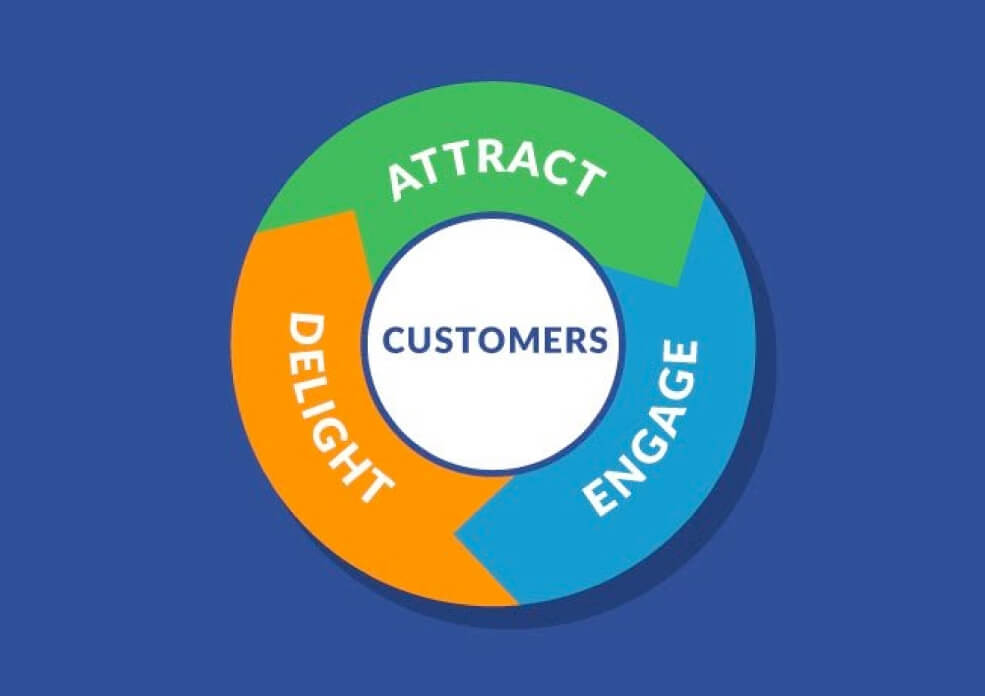

What is a flywheel? Well, we read the articles and called a few engineers to get to the bottom of this new term in sales and marketing and this is what we’ve come up with:
Flywheel
noun
Someone realized that this technical, and confusing, term would be great for marketing and sales teams. Which brings us to our definition, tailored for the evolving business world:
The point of shifting from a funnel to a flywheel is purely for the sake of the customers.
Customers have power, and they’re tired of being wooed and schmoozed through the sales funnel process. At the end of the funnel, they don’t fall into a hot tub of customer care. They usually fall off the company’s radar except for the occasional dry sales email.
The flywheel provides a different experience. Consequently, when you tie together service, marketing, and sales, you create a robust company with a dedicated and collective focus on the customers.
As the flywheel spins, customers fall into a vortex where they can always:
We’ve established the basis of the flywheel, but there are a few key takeaways to cover about the retiring funnel and the new heavy-weight champ.
1. The Sales Funnel Isn’t Dead (yet)
First, there is still a process needed to connect with and attract new leads. Every lead is at some point cold, or luke-warm and they need nurturing. Over time, we expect the marketing flywheel to take a larger role in this process because companies that use the flywheel will gain a reputation for outstanding customer care.
2. The Flywheel is About More Than Marketing
The idea of the flywheel is to pull in and protect customers. However, it doesn’t directly address the notion of leads because, essentially, you’re treating everyone as customers from the start. It’s 2021, and we’re finally figuring out that we should treat our customers better than our warm leads.
Let’s say someone comes across a company marketing campaign, and they show an interest. Then the sales team reaches out alongside support to learn more about the customer. Finally, marketing, sales, and support work side-by-side instead of pushing customers off of one person’s desk and onto another.
3. The Difference is a Matter of Approach
Customers that are loyal and naturally raise awareness for your brand are engaged, delighted, and constantly attracted to your company. However, most companies think of that situation and put it off because it sounds like a lot of work.
The flywheel allows companies to use their resources with more tact to accomplish these goals efficiently. You’re not asking your three primary teams to run at top speed all the time. Actually, it’s the opposite because using collaboration and proactive work means that customers receive more support and care with less internal effort.
The flywheel isn’t a self-perpetuating machine that will breed customer loyalty with little effort. Companies do have to put the work in and help to avoid flywheel friction.
There is the possibility of friction when:
This last issue is the most common when companies transition to flywheel thinking. Marketing, sales, and service all play a role in keeping the flywheel turning. So, if any section of the flywheel is heavier than the others it will introduce friction and reduce the momentum. This means it won’t turn properly, and will eventually come to stop.
Here is a quick breakdown that can help teams understand their part in the flywheel:

Leverage technology to reduce friction, align your teams, and ensure that your customers (including leads) get the best every time they interact with your company or product. Ultimately, companies can use complete business applications suites such as Zoho to manage customer relationships, marketing campaigns, support contacts, and more.
-Off you go! Your horizon awaits.